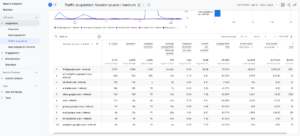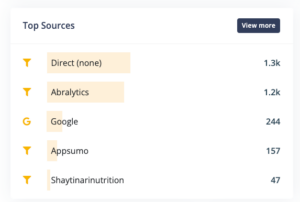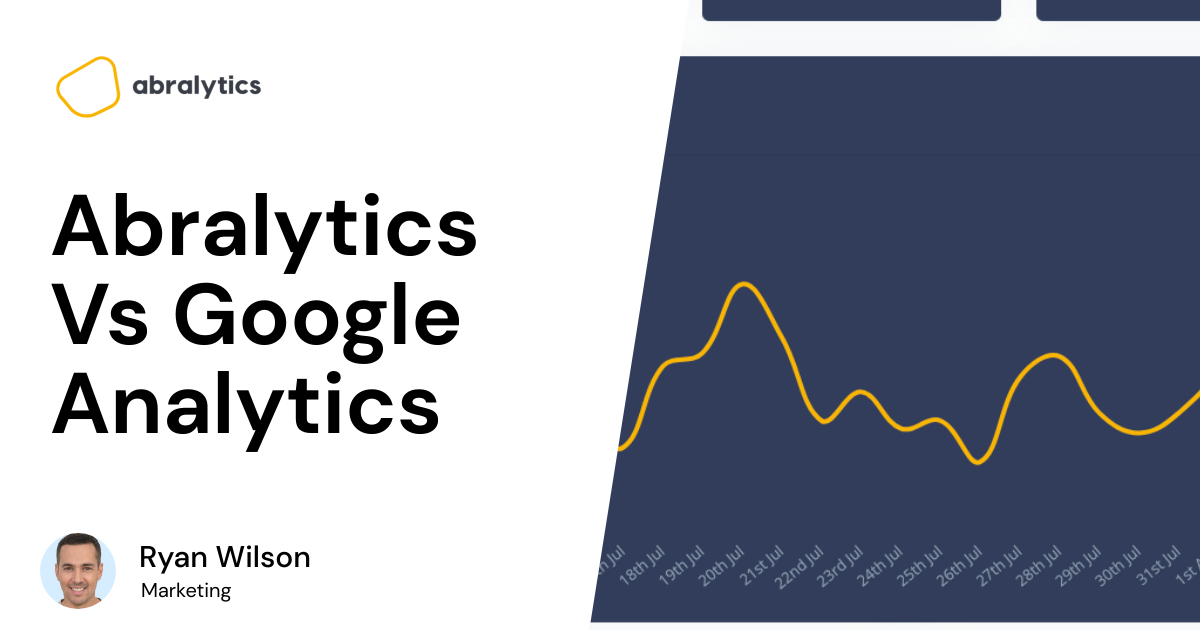What Referral Traffic Is In Google Analytics
Have you ever felt lost in the labyrinth of Google Analytics, especially when trying to pinpoint exactly where your traffic is coming from? Navigating the maze of menus and options can feel like searching for a needle in a haystack, leaving you frustrated and unsure if you’re making the most of your traffic data. According to Google, Referral traffic is identified as visitors that arrive at your site from direct links on other websites rather than directly or through searches. Referral traffic is crucial yet often misunderstood. Many marketers share this common predicament, struggling to translate referral traffic into actionable insights. That’s where Abralytics can come in—offering a streamlined, user-friendly alternative that simplifies your analytics needs.
Understanding Referral Traffic: Why It Matters
Referral traffic isn’t just another metric in Google Analytics; it’s a window into the effectiveness of your online partnerships and the external perceptions of your brand. Recognizing the sources that bring visitors to your site can help you identify which partnerships are fruitful and which platforms you might be overlooking. Here’s what we’ll cover to demystify referral traffic and maximize its potential:
- Definition and Importance: What referral traffic is and why it should matter to you.
- Identifying Referral Sources: How to find and analyze your referral traffic data in Google Analytics.
- Leveraging Referral Traffic: Strategies to optimize and increase traffic from referrals.
- Abralytics Advantage: How Abralytics simplifies tracking and enhances the insights from referral traffic.
Next, we’ll dive into the core of referral traffic, starting with its fundamental definition and importance. You’ll learn not just to track but also to leverage this data to forge stronger relationships and boost your digital marketing strategy.
Understanding Referral Traffic: Definition and Why It’s Crucial
Many marketers overlook referral traffic, focusing instead on direct visits or search engine traffic. However, understanding where your visitors come from can reveal which external sites are boosting your traffic and which might be leeching your credibility without providing value. Here’s how to make the most of this data:
- Start by filtering your Google Analytics to view referral traffic sources. This gives you a clear picture of which websites link to your page and how their audiences engage with your content. This information is vital for recognizing high-value partnerships. For instance, a high number of visitors from a niche blog could indicate a strong alignment with that audience, suggesting potential for deeper collaboration or targeted content.
- Evaluate the quality of traffic from each referral source based on metrics like session duration, bounce rate, and conversions. This assessment helps you distinguish between sources that drive engaged visitors and those that don’t. Create a simple dashboard in Google Analytics to track these metrics regularly, allowing you to quickly spot trends and adjust your strategy accordingly.
- Use the data to tweak existing campaigns or to inspire new initiatives. For example, if a particular referral source regularly leads to high conversions, consider investing more in similar channels or exploring co-marketing opportunities. A/B testing different referral strategies can help refine what works best for your audience, potentially increasing both traffic and conversion rates.
Referral traffic isn’t just a metric to monitor; it’s a strategic tool that, when understood and utilized properly, can significantly enhance your online presence and marketing effectiveness.
Identifying Referral Sources: Navigating Google Analytics
Uncovering where your referral traffic originates can seem daunting, but it’s a crucial step in harnessing the full potential of your digital strategy. Here’s how you can effectively identify and evaluate your referral sources:
 Source: Google Analytics Demo Account
Source: Google Analytics Demo Account
- Begin by accessing the ‘Acquisition’ section in Google Analytics, then navigate to ‘Traffic Acquisition’ and search ‘Referral’. This report lists the domains that have sent traffic to your website, providing a straightforward view of your referral landscape. Viewing this data allows you to see not just who is sending traffic, but also how much they’re sending, which can be pivotal in assessing the value of your external relationships.
- For each referral source, analyze key metrics such as page views, average session duration, and bounce rates. These indicators help determine the engagement and quality of the traffic coming from each referring site. You could use a visualization, like a heatmap, to quickly identify which sources are most valuable based on engagement metrics. This visual tool highlights areas of success and opportunities for improvement.
Identifying and analyzing your referral sources in Google Analytics allows you to not only understand where your traffic comes from but also how to engage these visitors effectively. By focusing on data-driven insights, you can optimize your marketing efforts to leverage the most beneficial partnerships and channels.
Leveraging Referral Traffic: Enhancing Your Marketing Strategy
Once you understand where your referral traffic is coming from and how it behaves on your site, the next step is leveraging this information to optimize your marketing efforts. Here’s how you can actively use referral data to boost your traffic and conversions:
- Identify which referral sources bring the most valuable traffic—those with high engagement and conversion rates—and focus on building stronger relationships with these partners. This might involve more collaborative content, joint promotions, or shared campaigns. Consider reaching out to these partners for guest blogging opportunities or joint webinars, which can further engage their audience and bring more qualified traffic to your site.
- Analyze the content preferences of visitors from different referral sources and tailor your content to better suit their interests. This targeted approach can significantly increase relevancy and engagement. If visitors from a particular tech blog engage more with your software tutorials, consider creating more content in this vein or even developing specific features or services based on this feedback.
- Optimize the paths that visitors take once they arrive via referral links. Ensure that the landing pages are highly relevant and offer clear, actionable information aligned with the interests of the referral traffic. You might create customized landing pages for visitors from specific referral sources. These pages could highlight information or offers that are especially relevant to that audience, increasing the chances of conversion.
Effectively leveraging referral traffic involves more than just understanding where it comes from; it requires actively engaging with these sources and optimizing your content and user paths to suit these visitors. By doing so, you can enhance your site’s performance and forge more productive and rewarding partnerships.
Abralytics Advantage: Streamlining Referral Traffic Analysis

Abralytics allows you to see your top sources and metrics on a single page
Navigating Google Analytics can be complex and time-consuming, particularly for businesses that lack dedicated analytics teams. Abralytics simplifies this process, making it easier for you to harness the power of referral traffic data. Here’s how Abralytics enhances your understanding and use of referral traffic:
- Abralytics features a user-friendly dashboard that highlights key referral traffic metrics at a glance. This eliminates the need to dig through multiple menus, providing a clear, concise view of where your traffic is coming from and how it’s performing. Imagine a dashboard that automatically prioritizes high-impact referral sources, so you can immediately see which partnerships are most valuable and deserve further attention or expansion. For example, use dynamic charts to track changes in referral traffic over time or during specific campaigns, helping you pinpoint what’s working and what’s not in real-time.
- Set up customizable alerts and reports that keep you updated on significant changes in your referral traffic. This proactive feature ensures you never miss an opportunity to optimize your strategies based on the latest data. You can receive automated alerts when there’s a spike in traffic from a new referral source or when an existing referral’s performance drops, allowing for immediate action to capitalize on trends or address issues.
- Optimize the paths that visitors take once they arrive via referral links. Ensure that the landing pages are highly relevant and offer clear, actionable information aligned with the interests of the referral traffic. You might create customized landing pages for visitors from specific referral sources. These pages could highlight information or offers that are especially relevant to that audience, increasing the chances of conversion.
Abralytics provides a streamlined, intuitive solution for managing referral traffic. By simplifying the analysis process and offering actionable insights through advanced tools, Abralytics empowers you to make the most of your referral traffic and enhance your overall digital marketing strategy.
Wrapping Up: Simplifying Referral Traffic Analysis with Abralytics
Navigating the complexities of Google Analytics to understand referral traffic can be daunting, but it’s crucial for optimizing your digital marketing efforts. Now, there are pros and cons of Google Analytics, but we’ve explored how to identify, analyze, and leverage referral traffic effectively, and how Abralytics can streamline these processes.
We delved into the importance of understanding where your traffic comes from, the significance of analyzing the quality of traffic from each source, and the benefits of optimizing your strategies based on these insights. Abralytics simplifies these tasks with a user-friendly interface, enhanced visualization tools, and customizable alerts to help you make data-driven decisions effortlessly.
Now, why not start by checking your current referral traffic in Google Analytics? See if you can identify one high-value source and consider strategies to enhance this partnership. If you have questions or want to share your experiences, drop a comment below—we’d love to hear about your journey in improving traffic acquisition.
Ready to take your analytics to the next level? Try Abralytics today and experience the simplicity and power of streamlined data analysis. Discover how easy it can be to enhance your marketing strategy with the right tools.




